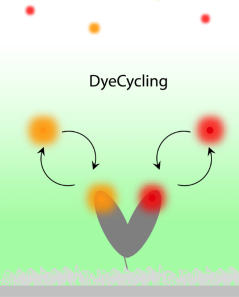
News
Breaking the photobleaching limit in single-molecule FRET with DyeCycling
In a new article, BIP researchers Benjamin Vermeer and Sonja Schmid describe a way to overcome a fundamental limitation of single-molecule fluorescence experiments, by which more than 100-fold more information can be gained per single molecule.

Single-molecule FRET is a powerful technique to measure the internal movements of single protein molecules in real-time and with sub-nanometerresolution. To do so, small dye molecules are chemically coupled to the protein of interest.
Unfortunately, those dye molecules bleach relatively quickly under the neededlaser illumination, which means the untimely end of the experiment. Vermeer and Schmid asked themselves: if dyes inevitably bleach, why don't we replace them?
This is also what happens in their DyeCycling approach: 'old dyes' are replaced by new fresh ones and photobleaching of a single dye does no longer terminate theentire experiment. This versatile DyeCycling approach can be implemented with standard equipment and with a range of chemistries.
Together with new technologies that arecurrently being explored in the NanoDynamicsLab, DyeCycling has the potential to revolutionize how people measure biomolecular dynamics using single-molecule fluorescence/FRET.